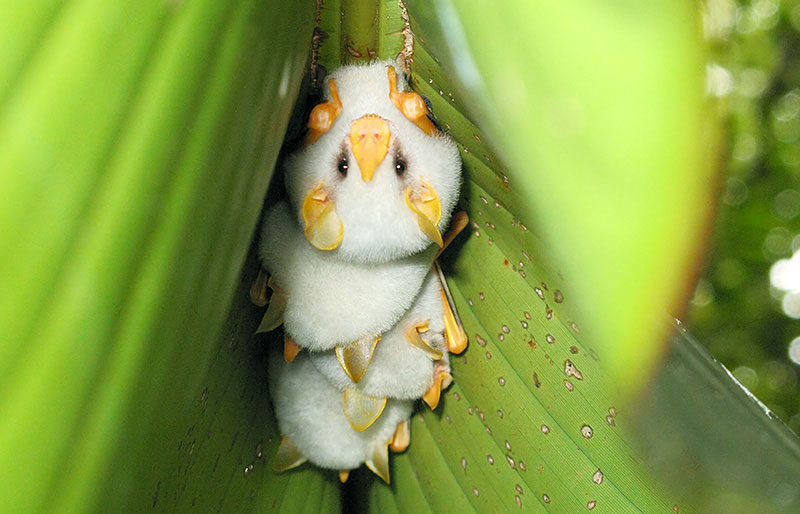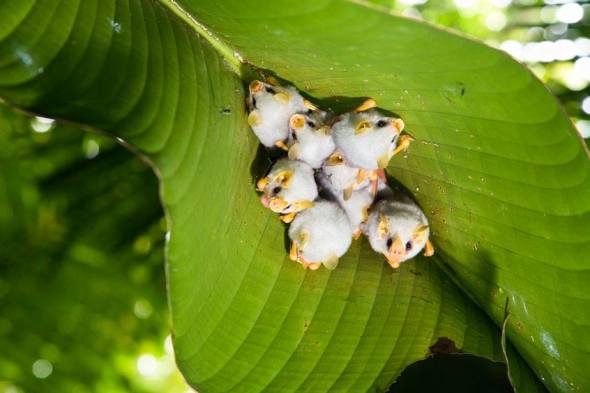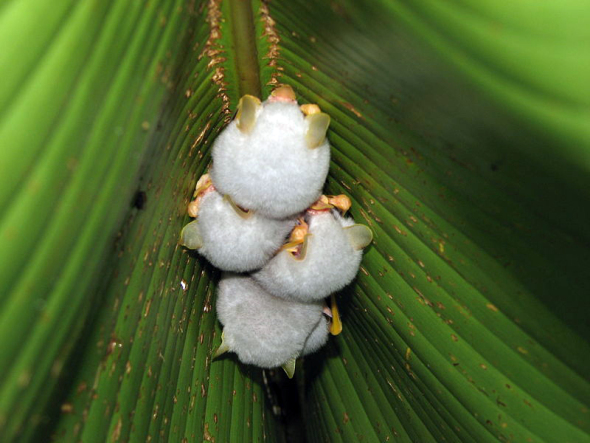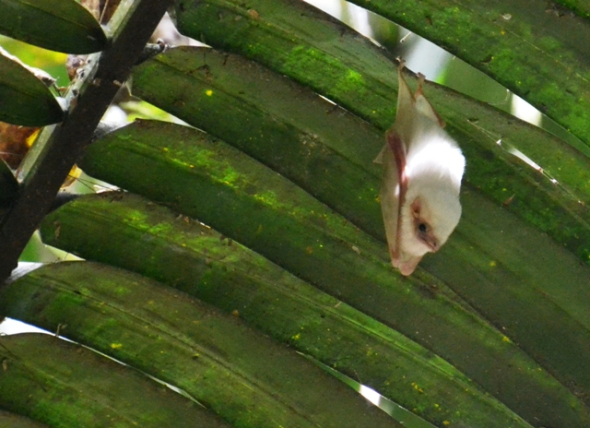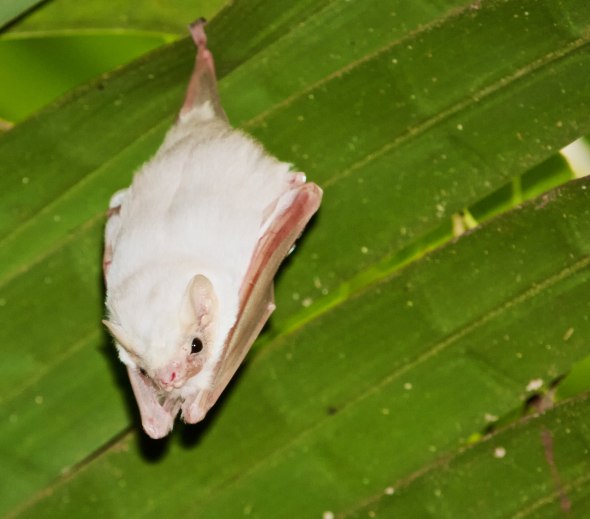Honduran White and Northern White Bat.
Some have stated they resemble the appearance of Furbies while others sate they look like cute little Gremlins. Well actually they are indeed Honduran Ghost Bats, commonly named as the (Honduran White Bat) that we featured on our main International Animal Rescue Foundation Endangered Species Article few days ago that we release every Monday and Friday.
The Honduran White Bat just one of two unique species of white bat that inhabits planet Earth featured this week on our Endangered Species Post as they are currently listed as (near threatened). Scientifically named as Ectophylla alba populations of this very small (pygmy) style bat are on the decline. To what extent we are still unaware. Data on diet, population trend and behavior is limited.
White bats like all bats fall into the order of Chiroptera. Chiroptera is an ancient order of mammalia dating to the early Eocene, including the bats. They are nocturnal mouselike mammals having four toes of each of the anterior limbs elongated and connected by a web, so that they form membranous wings that can be used in flying. They also have anatomical adaptations, including large ears, for echolocation, by which they navigate and in some cases find insects. The order includes the suborders Megachiroptera (the fruit bats) and Microchiroptera (insectivorous bats). See Bat. Previously spelled cheiroptera.
Identified back in 1892 by Dr Joel Asaph Allen (July 19, 1838 – August 29, 1921) was an American zoologist and ornithologist. Dr Allen was one of worlds leading and most professionally sound experts in zoology and ornithology of which his work is still spoken about to this very day at many universities globally.
Allen was born in Springfield, Massachusetts. He studied at Harvard University under Louis Agassiz, and took part in Agassiz’s 1865 expedition to Brazil in search of evidence of an ice age there, which Agassiz later claimed to have found, and in others within the United States. Allen later crossed into Honduras and Panama in search of the elusive Honduras white bat.
Native to Costa Rica, Honduras, Nicaragua and Panama the Honduras White Bat has very few major threats. This doesn’t though for one minute mean its very few threats are indeed large to the species of Honduras White Bat. Populations are rapidly declining like many bat species internationally. The Honduras White Bat have habitat preference. In Costa Rica the population declined, food preference and habitat restriction is known.
Habitat fragmentation, forest clearance, poaching and trade are known “threats” to both species of white bat found exclusively within this area of the world. However little documentation has been compiled to indicate just how bigger threats these pose. International Animal Rescue Foundation World Action Brazil did back in 2012 monitored the Ectophylla alba of which noted land clearance and deforestation, timber trade posing as a significantly increased threat to “some fruit trees that the bat feeds from (again little data was compiled). The primary food source of the Honduran White Bat is fruit of which some food sources are being threatened with intense agriculture and land clearance to cope with human population inclines.
The Honduran White Bat is unique among most bats (but not many tropical bats) in that it will modify its immediate surroundings for its own benefit. Unlike the misconception that all bats live in caves, this bat will use the leave of the large Heliconia plant to form a tent.
It does so by cutting the side veins of the plant that extend out from the midrib; this causes the leaf to droop along the stem, making a tent. The little white bats then cling to the inner plant upside-down in small colonies of around six, although larger groupings have been reported. Unlike most bats that do make tents – the Honduran White Bat will not flee if disturbed lightly by looking under the leaf – they will only flee when the stem itself is disturbed causing a brief flurry of activity.
The advantage of having their white fur is postulated to be the reason – as when sunlight filters through the leaf they look green, and so by not moving they will go un-noticed by possible predators from below. We do not know of any other species of bat or bird that (mimics) its surroundings to protect itself from predation as the Honduran White Bat species does.
Within the last ten years there has been a decline of some thirty per cent of Honduran White Bat populations of which falls under the classification of (near threatened). Ectophylla alba is not known to be common.
Roosting in groups of 4 to 8 in tents and found mainly in (protected areas) the Honduran White Bats are also known to inhabit the Caribbean low lands too at a level of 700m.
Little did we know when publishing the article (Monday 1st September 2014) on the white bat did some 100,000 people and counting not even realize this bat existed, even among some high profile bat enthusiasts which is of some concern to us because the species is listed as near threatened. with a population decline still ongoing its articles such as these that need further exposure in the hope of encouraging others to document on the species and increase awareness in the hope that it will furthermore halt declines and preserve the Honduran White Bat for many hundreds of years to come.
Honduran White Bats are uncommon but local of which threats to the species are listed only in brief. Both males and females construct the tent by biting the leaf veins and pulling the leaf into shape. At the end it always looks like an upside-down boat. They only use seven types of plants for their shelters, and most tents are built in two different kinds of Heliconia species. A good tent- leaf has to be less than 2 m (6 feet) high. Probably to avoid high temperatures in the roost during the day, tents are built where the canopy is nice and thick, although the plant species used for tent building grow under thick as well as under more open canopy. Another important characteristic of useful leaves is that there are only few plants underneath, which is the bats’ way to avoid having predators sneak up to their roost. Honduran white bats only use fresh, new leaves to build their tents, probably because they are undamaged and still softer and therefore easier to bite. After all, these bats are tiny; the body is barely bigger than a nice juicy cherry. Thus the leaves cannot be too tough for the bats to be able to modify them. (see picture below).
Because of these preferences for roosts, Honduran white bats live primarily in mature secondary forests. Very young forests are unsuitable for the bats because they have a very thick understory and an open canopy, whereas mature forests have very few suitable tent plants. But even though secondary forests are common where Honduran white bats occur, the bats are vulnerable to habitat loss because they have very specific needs with respect to roosts. Therefore, continued conversion of forests to agricultural areas will decrease the options for Honduran white bats. (see video below for further information)…
Major threats to our Honduran White Bat is known to be (habitat restriction) that can be anything from deforestation, habitat loss from unsustainable agricultural practices and legal timber trade. Slash and burn techniques although not documented would most likely be a factor that would/could see the species placed in danger furthermore too.
So what do we know about threats associated with the Honduran White Bat? Lets take a look.
Deforestation is a primary threat to many species of wildlife within Costa Rica, secondary threats to white bats could well be the decline of its own roosting plant the Heliconia from which the Honduran bat uses as a safe roost making a well woven tent to keep up to twenty bats a time safe from predators.
Deforestation;
Deforestation is a major threat to biodiversity and ecosystems in Costa Rica. The country has a rich biodiversity with some 12,000 species of plants, 1,239 species of butterflies, 838 species of birds, 440 species of reptiles and amphibians, and 232 species of mammals, which have been under threat from deforestation. Costa Rica is home to the majority of white bast species.
Deforestation in Costa Rica has a serious impact on the environment and therefore may directly or indirectly contribute to flooding, desertification, sedimentation in rivers, loss of wildlife diversity, and the obvious sheer loss of timber. Since the end of World War II, approximately 80% of the forests of Costa Rica have disappeared. Approximately 20,000 acres (8,100 ha) of land are deforested annually; in the 1990s the country had one of the worst deforestation rates in Central America.
As the population grew, the people of Costa Rica cut down the forests to provide for pastureland for cattle ranching to produce beef for the world market to raise revenue. Since the 1950s, approximately 60% of Costa Rica has been cleared to make room for cattle ranching. The problem was worsened because during the 1960s, the United States offered Costa Rican cattle ranchers millions of dollars in loans to produce beef. The deforestation of Costa Rica’s tropical rain forests as in other countries is a threat to life worldwide with a profound effect on the global climate. Soil erosion has increased with deforestation with the topsoil washed away from the hills into the streams and out into the oceans, year after year.
Over half of Costa Rica’s existing forest cover today is under the protection of national parks, biological reserves, or wildlife refuges. However, the major problem in regards to deforestation is the privately owned plots which occupy the other half. Lenient laws on land and amendments to forestry law makes it easy to obtain logging concessions as owners exploit the land to maximise income.
As logging companies enter these forests to exploit them, they require access roads to transport the timber. While cattle ranching is by far the primary cause of deforestation in Costa Rica, banana plantations have also significantly contributed to the problem. Lowland rainforest has been most affected where 130,000 acres (530 km2) of previously forested land (primarily in the Atlantic and Northern regions) have been removed.
Such industries have been synonymous with health risks, notably the high levels of toxic pesticides which affected thousands of plantation workers throughout Central America in the 1970s. Pesticides used to grow bananas and other fruits such as mangoes and citrus fruit may enter the hydrological systems and contaminate the water. The removal of the forest to make way for these fruit planatations may also disrupt the nutrient balance in the soil and through monoculture exhaust the soils and render them unsustainable.
Although most of the larger plantations in Costa Rica are owned by large companies, often multinationals, population pressure in Costa Rica has increased the demand for land among farmers who are forced to venture out onto new land to deforest and farm and compete over scraps of land. While certain conservation laws have been passed in Costa Rica, the government lacks the resources to enforce them.
Light Pollution;
Light pollution could affect the regeneration of tropical rainforests because it disrupts the behaviour of seed dispersing bats, a study suggests. Researchers found that a species of fruit-eating bats in Costa Rica avoided foraging in artificial light. The team warned the findings suggested light pollution could have a negative impacts on ecosystems, and called for light-free refuges to be established. The findings have been published in the Journal of Applied Ecology.
Each year, large swaths of rainforest are cleared and converted to agricultural land. The team says the land is often abandoned when the soil fertility falls, making it uneconomic to grow crops. The team observed: “Natural succession of abandoned land could counter the loss of biodiversity, but the rate of natural reforestation is slow.” They added that fruit-eating bats help rainforest plants re-colonize the land because the mammals seemed to “tolerate habitat disturbance when dispersing seeds”.
“Under naturally dark conditions, bats produce a copious seed rain - even in deforested habitats and connect distant forest fragments,” they wrote.
“Yet, artificial light at night may compromise bat-mediated seed dispersal if bats avoided lit areas.”
Light sensitive;
In order to test the idea, the researchers studied the feeding behaviour of Sowell’s short-tailed bats (Carollia sowelli) - which feed on the fruits of pepper plants. The impact of light pollution could be reduced by… setting up dark refuges connected by dark corridors for light-sensitive species” Initially, they carried out an experiment using captive bats to demonstrate that food was often left unexplored or consumed when a compartment was dimly lit in comparison with dark compartments.
They said this indicated that “artificial light altered the foraging behaviour of fruit-eating bats”. In order to see if this behaviour was replicated in the wild, the researchers observed wild bats’ response to light emitted from a street lamp.
“We found that [fruits] were less likely to be harvested when plants were illuminated by a street lamp than under natural darkness,” they said.
Although previous research has shown that insect-eating bats’ foraging behaviour was adversely affected by artificial light, this was the first study to indicate that fruit-eating bat species also avoided lit areas. The findings suggested that light pollution could have adverse consequences for forest regeneration in the tropics, explained co-author Daniel Lewanzik from the Leibniz Institute for Zoo and Wildlife Research, Berlin. “In tropical habitats, bat-mediated seed dispersal is necessary for the rapid succession of deforested land because few other animals than bats disperse seeds into open habitats,” he said. In their paper, the team warned: “Policymakers of tropical countries should become aware of the potential detrimental effects of artificial lighting on wildlife and ecosystem functioning.” Mr Lewanzik added: “The impact of light pollution could be reduced by changes in lighting design and by setting up dark refuges connected by dark corridors for light-sensitive species like bats.”
Food Declines and Climatic Change;
Bats seem to have evolved as moderately long-lived (e.g., 5-30 years), intelligent creatures that are acutely in synchrony with global climates. Worldwide, bats are known to depend on a variety of natural resources. Many tropical species are dependent on nectar, pollen, and flowers and fruits of plants and are known to “track” the development of the plant resources upon which they depend. Not surprisingly, bats are frequent and important pollinators of plants, especially in tropical areas and on island ecosystems in the Pacific. Additionally, many bats rely on plants (especially trees) as roosting sites for varying periods of time. Disturbances to climate that interrupt or alter the phenology of plants, or greatly alter plant species occurrence or distribution, can be expected to affect bats. For example, a mean global warming of 3 C will change climates sufficiently so that 7-11% of vascular plants in North America will no longer occur within the appropriate climate “envelope.” This will require that such plants will have to adapt to the change, move to stay within the appropriate climate, or become extirpated. Such disruptions will likely affect bats.
Other species of bats, especially in temperate zones, are insectivorous and collectively consume large quantities of insects. Just as pollinating activities of bats are important to plant ecology, the insectivorous food habits of bats play an important role in maintaining a balance among insect populations. Although studies of bats have demonstrated some flexibility in food habits over time, most species appear to be specialized to pursue and capture selected kinds or categories of insects. Furthermore, bats are dependent upon a reliable and consistent “supply” of prey, even though specific insect populations grow and disappear over the course of a summer season. Changes in worldwide insect population occurrence or distribution can be expected to affect numbers and species diversity of bats.
In temperate latitudes, both northern and southern, bats avoid seasonal food shortages by either hibernating, often in caves or mines, or by migrating to regions where food is still available. We suspect that nearly all attributes of hibernation or migration are mediated by combinations of changes in ambient light regimes, temperature, and food resources. The dependence of temperate-zone bats on the interplay of these factors ultimately revolves around the bats’ ability to acquire sufficient energy (in the form of food) to either last them through a hibernation sequence or through the rigors of (sometimes) long-distance migration. Temperature changes that would affect the supply of food to bats or otherwise upset an energy balance that has evolved over millenia should have significant consequences for bats. Also, climate changes that would lead to changes in the internal temperatures of roosts that have been used by bats for decades will force bats to locate and use new or different roosts.
While the Honduran White Bat may seem cute and adorable it must be stated that removal of the bat from its natural habitat to domestic it for pet purposes is something we frown down upon. These bats like any other species must not be removed nor feed into the pet trade industry. When releasing our article on Monday this week we were a little concerned at the amount of comments from the public that quoted they “wanted one” “where can I purchase a white bat from” down to one comment “Going to take a few for my collection of bats”. Honduran White Bat is listed as (near threaded) so by reducing the species within the wild for domesticated purposes one is only adding to the further decline of the species.
While we documented on the Honduran White Bat we did state that a further write up on the second only known white bat would come later on during the week. The Northern “Ghost” bat commonly known as the (Northern White Bat) is related to the Honduran White Bat. Whilst listed as (least concern) and at lower risk, the Northern Ghost Bat is said to be the worlds rarest bat on planet Earth. Please view the picture below of the Northern Ghost Bat scientifically identified as Diclidurus albus.
This species occurs from Nayarit (Mexico) to eastern Brazil and Trinidad.
Native to;
Belize, Bolivia, Plurinational States of Brazil, Colombia, Costa Rica, Ecuador, El Salvador, French Guiana, Guatemala, Guyana, Honduras, Mexico, Nicaragua, Panama, Paraguay, Peru, Suriname, Trinidad and Tobago and Venezuela.
D. albus prefer humid habitats like riparian and tropical rainforests but have been found in human-disturbed areas like plantations, clearings, and over villages. They are solitary, and like all members of the family are insectivorous.
Like the Honduran White Bat they too roost in plantations. Roosts can be found in caves, deep rock crevices, and old mines. Although ghost bats prefer to roost in colonies, they currently only roost in small groups at best due to a lack of roosting sites that support larger colonies. It is unusual for there to be a colony of more than 100 bats in one location. It often roosts singly under palm leaves. Whereas the later species will only roost under Heliconia plantation leaves.
Please do not confuse these two species of “white bats” “ghost bats” with the very rare Australian Ghost bat that is much larger in size and believed to be only endemic to Australia.
Conclusion;
Since Honduran white bats live mainly under heliconia leaves, rainforest destruction is a serious threat. For this species to survive, rainforests in the Central American lowlands that have heliconia must remain standing. Natural predators may include opossums, snakes and other carnivorous animals. During the day, Honduran white bats roost under their tents. At night, they emerge to search for food. However, these creatures are not looking to suck your blood — they only eat fruit or vegetation.
Josa C Depre
Environmental and Botanical Director
International Animal Rescue Foundation

